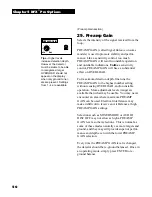
52
V.D.I. Normalization - Used in the 1 frequency operat-
ing modes to correct the skewing of the traditional
(6.59 kHz) V.D.I. number display calibration. 2
Frequency modes require Normalization and thus it is
automatically ON in both the 2 Frequency (Best Data)
and 2 Frequency (CORRELATE) operating modes. It
is not an option in 2 Frequency modes.
When operating in the 1 Frequency (3 kHz) mode
Normalization ON recalculates the V.D.I. display
information to represent traditional V.D.I. display
calibration at White’s traditional frequency 6.59 kHz.
When OFF in the 1 Frequency (3 kHz) mode the
V.D.I. scale is distorted/expanded in the higher end of
the scale (copper/silver) and compressed in the lower
end of the scale (foil/nickel). This distortion can be
used to provide higher display or discrimination
resolution in this copper/silver coin area of the scale.
DISC EDIT will have to be configured to take advan-
tage of this expanded resolution.
When operating in the 1 Frequency (15 kHz) mode
Normalization ON recalculates the V.D.I. display
information to represent traditional V.D.I. display
calibration at White’s traditional frequency 6.59 kHz.
When OFF in the 1 Frequency (15 kHz) mode the
V.D.I. scale is distorted/expanded in the lower end of
the scale (foil/nickel) and compressed in the higher
end of the scale (copper/silver). This distortion can be
used to provide higher display or discrimination
resolution in this foil/nickel area of the scale. DISC
EDIT will have to be configured to take advantage of
this expanded resolution. The advantage is gold
jewelry and aluminum may be better sorted with
higher resolution in this foil nickel range.
V.D.I. NORMALIZED
ON
OFF
TO CHANGE PRESS
ENTER
32. V.D.I. Normalization
1 FREQ. (3 KHZ)
ON
OFF
TO TURN ON PRESS
ENTER
33. 1 Frequency (3 kHz)
1 Frequency (3 kHz) - Operates at 3 kHz exclusively.
Provides for superior high iron mineral rejection and
depth when salt is not present. Also provides for better
depth on higher conducting metals such as copper and
silver alloys.
1 Frequency (3 kHz) provides an alternate search
mode when iron (without the presence of salt) is
extreme and the primary target is higher conducting
metals such as copper or silver. Some of White’s early
1970 models operated at 3 kHz and are still revered
for there performance in high iron black sands.
1 Frequency (15 kHz) - Operates at l5 kHz exclu-
sively. Provides for superior performance in medium
to low mineralization (without the presence of salt)
and/or when lower conducting gold and nickel range
targets are the primary targets.
1 Frequency (15 kHz) provides an alternative search
mode when the ground minerals are not severe (with-
out the presence of salt) and/or when lower conducting
metals such as gold/nickel are the primary targets.
34. 1 Frequency (15 kHz)
1 FREQ. (15 KHZ)
ON
OFF
TO TURN ON PRESS
ENTER
Chapter 5 DFX
™
Pro Options
(Multi Frequency Method section)
(Multi Frequency Method section)
(Multi Frequency Method section)
0
20
40
60
80
15 kHz
6.5 kHz
3 kHz
100
dollar
quarter
dime
zn penny
pulltab
nickel
foil
Normalization OFF
Normalization OFF chart for 3 kHz expands the high (copper/silver) end of the scale and
compresses the low (foil/nickel) end of the scale. In the 15 kHz mode the opposite occurs.
The high end compresses and the low end expands.









































